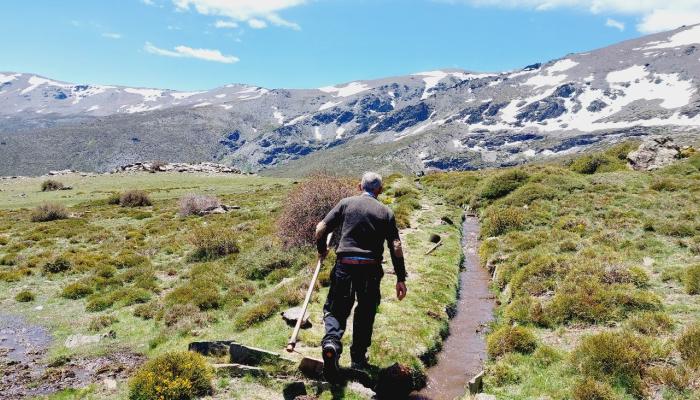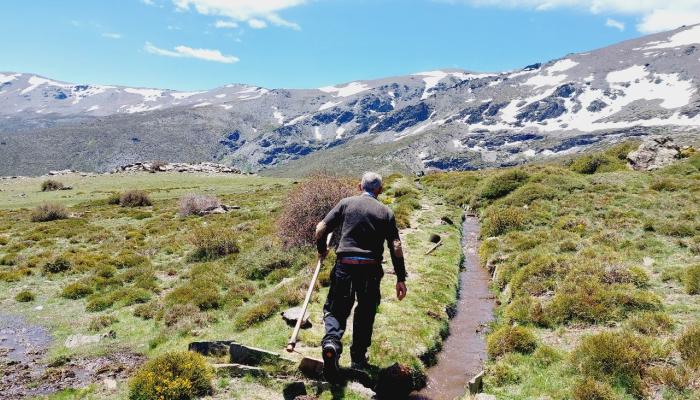
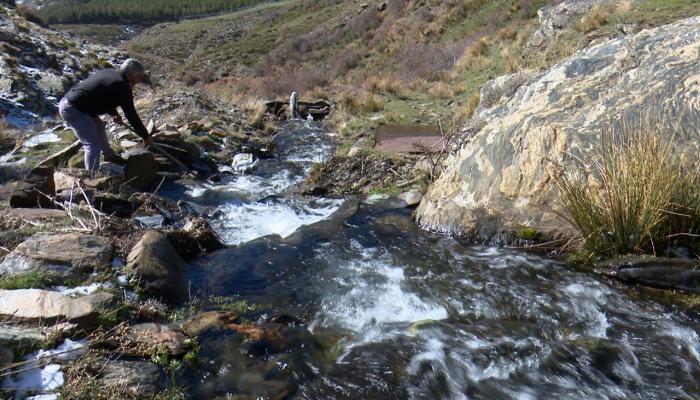
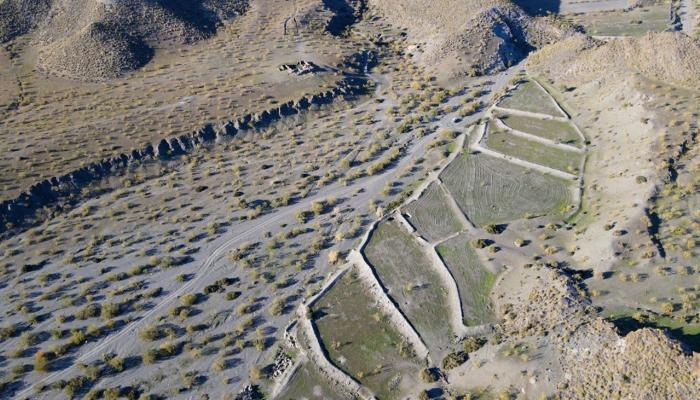
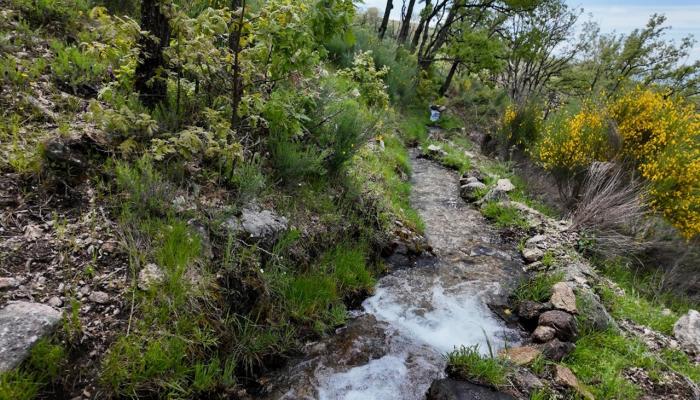
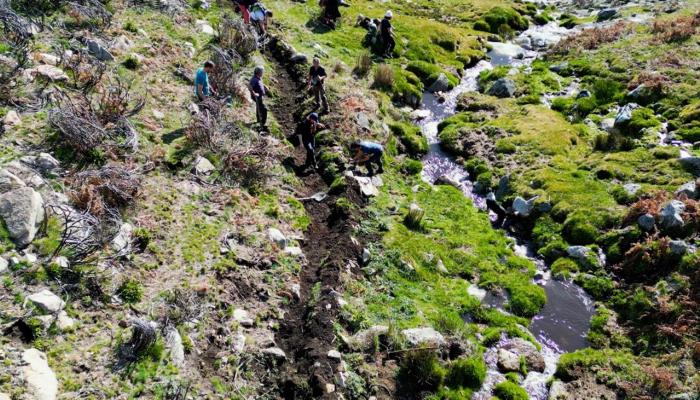
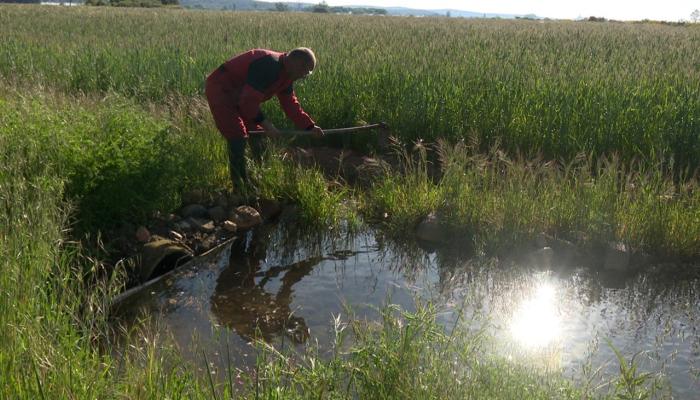
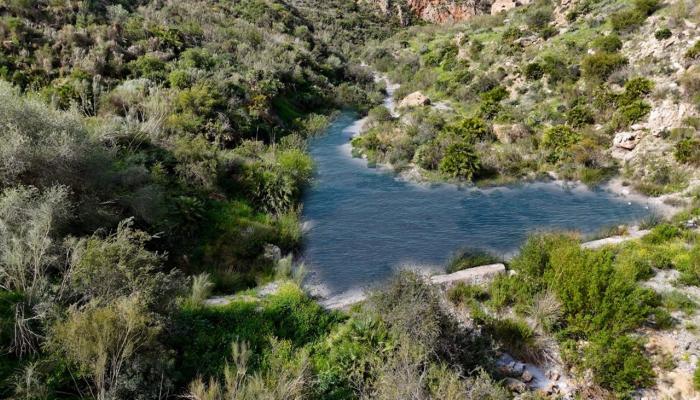
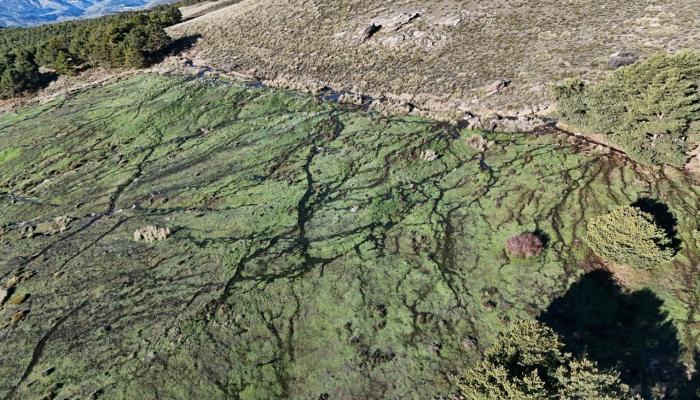
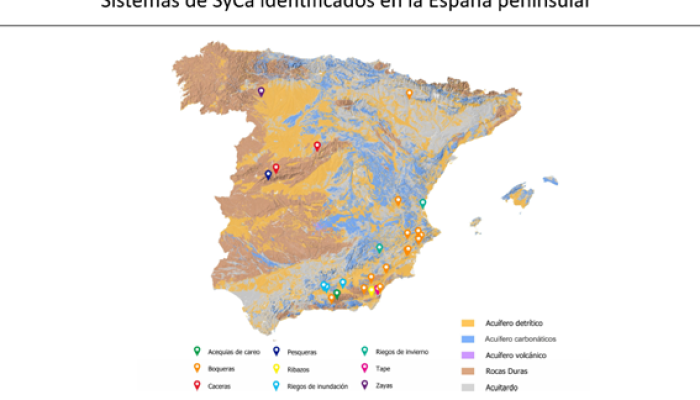
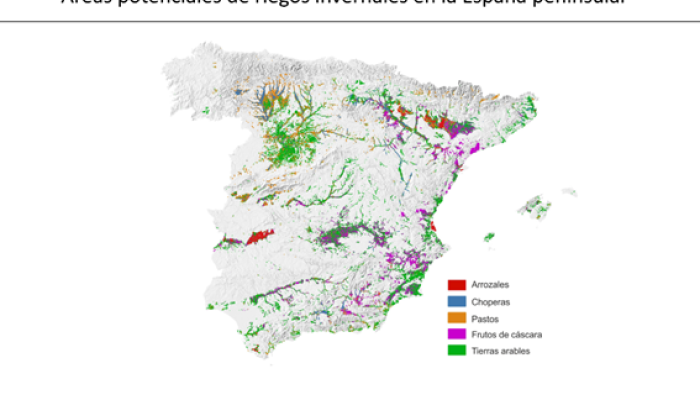
A little over a thousand years ago, humans developed techniques to retain runoff water by promoting its infiltration into the subsoil. This method of storing and managing water is known as Water Sowing and Harvesting (SyCA).
The WaSHa Project seeks to revive and enhance these traditional practices by combining local ecological knowledge with modern scientific approaches. Various systems have been inventoried and classified as intentional (such as infiltration ditches and furrows) and unintentional (including returns from flood irrigation, winter irrigation, irrigation of pastures, riverbanks, and boqueras, among others).
Among the water harvesting systems, dug wells and drainage galleries stand out, with thousands found throughout the region. Detailed studies conducted at three demonstration sites have shown that natural aquifer recharge can be doubled.
These are, therefore, living examples of climate change adaptation tools and Nature-based Solutions (NbS). The project once again demonstrates how learning from the past can inspire efficient and sustainable solutions to today’s challenges.
Water Sowing and Harvesting (SyCA) comprises a set of ancestral techniques designed to increase aquifer recharge and soil moisture (“sowing”) by capturing and infiltrating rainwater and runoff through various methods, or by managing traditional irrigated areas and pastures appropriately — with the ultimate goal of recovering this water (“harvesting”) at a later time.
SyCA operates using gravity, relies on local materials, and takes advantage of the natural regulation and purification capacities of ecosystems, soils, aquifers, and rivers. Beyond increasing aquifer recharge and the water available for plants, SyCA enhances ecosystem health, boosts biodiversity, and provides a wide range of ecosystem services in the areas where it is implemented.
Thanks to its collective and participatory management, SyCA stands as an exemplary Nature-based Solution (NbS) for sustainable water management. It offers a replicable model that helps mitigate the effects of water-related disasters, such as droughts and floods. It is, in essence, a proven tool for climate change adaptation, whose effectiveness has been demonstrated for centuries in the regions where it has been applied.
The observational and experimental capacity of farmers has always been remarkable. From a modern Western perspective, it is often surprising—since we tend to underestimate not only their traditional knowledge but also their ability to learn, experiment, and innovate. This, without doubt, represents the first barrier encountered when studying practices such as SyCA from an academic standpoint.
The second major challenge is the abandonment and loss of traditional knowledge resulting from the profound social and cultural transformations of recent decades, which have also driven radical changes in practices, landscapes, and land use.
Recovering and reconstructing this knowledge and its associated practices often requires work that is as much archaeological as ethnographic. In reality, what is truly needed is a transdisciplinary, systemic, and open perspective—one that enables us to understand how human societies have historically interacted with nature and developed agrarian-based socio-ecosystems that made sustainable use of available resources.
The general objective of the project is to inventory, characterize, and promote the various historical water management techniques developed in Spain, collectively known as Water Sowing and Harvesting (SyCA) systems.
To achieve this overarching goal, four specific objectives have been established:
1. Inventory historical SyCA techniques.
2. Disseminate and complement existing research on SyCA systems that are still in use in Sierra Nevada (Granada), La Vera (Cáceres), and Valduerna (León).
3. Identify potentially recoverable SyCA areas, develop restoration and reactivation proposals, and formulate management and operational recommendations.
4. Disseminate and transfer the knowledge gained through the project.
The restoration of traditional water sowing systems, as is already being undertaken in the case of infiltration ditches in Sierra Nevada (careos), in Gredos (pesqueras) and in Guadarrama (caceras and regaderas), involves reusing historical hydraulic infrastructures to enhance aquifer recharge along mountain slopes. These aquifers, through their slow groundwater discharge, ensure a steady water supply for both ecosystems and local populations during drought periods.
Similarly, the recovery of traditional terrace irrigation and the construction of banks and small dams can further increase aquifer recharge while reducing slope erosion.
However, one of the most promising outcomes of the WaSHa Project lies in the potential to replicate aquifer recharge at the national level, using existing agricultural infrastructure on unconfined aquifers. This recharge system would involve utilizing crop fields, unlined canals, and ditches to infiltrate water into the subsoil through winter or flood irrigation during periods of surface water surplus.
The implementation of this Managed Aquifer Recharge (MAR) technique—already applied on a large scale in California and Nevada—could have enormous potential for aquifer replenishment. Nevertheless, its use should aim to increase drought resilience rather than to expand agricultural demand, given that most aquifers are already subject to intensive exploitation.
The application of this technique, particularly winter irrigation, requires comprehensive agronomic and hydrogeological research that has yet to be carried out. It is essential to determine which crops can tolerate this type of irrigation, how productivity might be affected, which hydrogeological conditions are most suitable, what compensation mechanisms could be established for farmers, and how this management system can be integrated into water planning and governance within the hydrographic districts of Spain.
In addition, further research and the re-adaptation of the boquera system—which diverts stormwater towards areas designed for infiltration and sediment retention—would be of great value in addressing increasingly frequent climate-related challenges such as droughts and floods.
The SyCA systems that have survived to the present day, some of them more than a thousand years old, are living and paradigmatic examples of climate change adaptation systems. These are systems that have already demonstrated their validity and resilience, having overcome significant climatic and social changes throughout their long existence.
Most of the inventoried water sowing systems started in the Middle Ages, while the water harvesting systems such as wells, the oldest in the peninsula, are more than 4000 years old (Pozo de la Motilla del Azuer), or more than 2000 years in the case of the draining galleries that fed some Roman aqueducts.
The essence of SyCA is adaptation, since they are systems designed to have water available during periods of drought and, in some cases, to take advantage of water from torrential floods, to retain it, infiltrate it and to capture fines and soils eroded during storms.
The actors involved in the WaSHa Project have primarily been farmers and livestock breeders, as they are the ones who traditionally manage these ancestral water management systems. From these communities we have learned—and continue to learn—how, using local materials, the force of gravity, and ecological knowledge rooted in the territory, it is possible to retain water by harnessing the natural regulatory capacity of ecosystems, soils, and aquifers.
The work carried out by those who “sow water” generates direct benefits for them, but also provides a wide range of ecosystem services from which society as a whole benefits, even though no compensation is usually provided to the groups that create and maintain these services.
The involvement of irrigation communities and rural associations in the project’s pilot sites has been essential and exemplary. These groups have actively supported our team, sharing knowledge and information, assisting in fieldwork, and participating in volunteer-based activities aimed at the revival of traditional water sowing systems. Their commitment has been so strong that we are now jointly submitting new project proposals to continue the recovery and reactivation of SyCA systems.
Across the three work areas, we have organized opening and closing sessions, field-based restoration activities, and scientific dissemination conferences. Throughout the project, direct and ongoing communication has been maintained to monitor climatic, hydrological, and social developments in these territories during the implementation period.
The opening sessions focused on informing irrigators, management and planning authorities, and local residents about the work to be undertaken, its relevance, and the objectives pursued through WaSHa. The closing sessions presented the results, conclusions, and management recommendations derived from the project. In addition, a variety of documentaries, videos, and informational brochures were produced and distributed, featuring educational itineraries to help the public discover and understand the diversity of SyCA systems.
The cleaning and rehabilitation of infiltration ditches (such as ditches and pesqueras) have allowed for the reactivation of previously abandoned structures, restoring their original function. Through these volunteer initiatives, participants gained first-hand understanding of how these channels work and how they enhance water infiltration into the ground. These activities were crucial for strengthening ties between the local population and the project team, while also connecting volunteers from urban areas with rural communities, and engaging local youth in the knowledge and practice of traditional water management in their own territories.
Two Hydrogeodays have also been held—in 2024 in La Valduerna (León) and in 2025 in Lanjarón (Sierra Nevada, Granada). These Hydrogeodays are public outreach events on groundwater, designed to share with the general public the knowledge and insights gained through the WaSHa Project.
During the execution of the WaSHa project, the great interest in researching and recovering these water management techniques has become evident.
SyCA works with the force of gravity, with local materials and takes advantage of the regulation and purification capacity provided by ecosystems, soil, aquifers and rivers. SyCA, in addition to increasing the recharge of aquifers and the water available for plants, improves the state of ecosystems, increases biodiversity and offers a large set of ecosystem services in the environments where it is carried out. For all of the above and for its collective and participatory management, SyCA is susceptible to being replicated as an NBS, which is to reduce the effects of water-associated disasters, such as droughts and floods.
The challenge posed by this project is to be able to replicate these systems on a large scale, to recover the state of our battered aquifers and to recover the groundwater discharges to rivers and springs that occurred before the massive irruption of localized irrigation and the increase in irrigated area in our country.
This project shows that it is possible to recharge the aquifers on the slopes of our mountains by means of infiltration channels such as irrigation ditches, irrigators, hunts and fishing ditches, that it is possible to increase the recharge of aquifers, even in the arid areas of the southeast of the peninsula, with boqueras, banks and tapes and that it is possible, taking advantage of the existing irrigation infrastructure in the main irrigable areas of the country, imitating the zaya system, recharge the main aquifers of our territory.
But to carry out this small revolution, we must bring about a change of approach with respect to water management and planning, a change that seeks the long-awaited Ecological Transition. It requires understanding that irrigation returns are not lost, that when aquifers are irrigated, the water does not disappear, that it is discharged by rivers and springs, supplying many ecosystems that depend on groundwater. It requires compensating with payments for environmental services to farmers who recover and maintain the SyCA systems in rural areas, as well as to irrigators who begin to irrigate winter or flood irrigation to recharge aquifers.
It is therefore necessary to recover and expand the use of these traditional practices, adapting them to contemporary needs, which could allow not only the restoration of agricultural ecosystems, but also the improvement of biodiversity and the mitigation of the negative effects of climate change. Without an integration of this traditional ecological knowledge into agricultural and water management policies, there is a risk of losing effective and sustainable solutions that have been tried and tested over centuries.
In conclusion, the WaSHa project highlights the importance of traditional peasant knowledge and the value of SyCA practices as examples of climate and ecological adaptation that could be key to addressing the environmental challenges of the present and the future.
The results of the WaSHa Project have confirmed that managed aquifer recharge (MAR) in Spain is both feasible and cost-effective. Within the framework of this project, nearly two million hectares of arable land, rice fields, pastures, poplar groves, and nut-producing areas have been identified as potential sites for implementing managed aquifer recharge through existing agricultural infrastructure.
This finding opens up an entirely new field of research and application, where agricultural and hydrogeological disciplines can collaborate to design effective recharge systems. It also highlights the need to develop mechanisms for compensating farmers and livestock breeders for their role in recharging aquifers and for the ecosystem services generated by enhanced groundwater storage and availability.
Equally important is the need to address how such measures can be integrated into agricultural policy and hydrological planning, since current frameworks often promote a narrow concept of water-use efficiency—one that prioritizes agricultural yield over the broader ecological benefits to ecosystems, rivers, and aquifers. This remains the main limiting factor for initiatives of this kind.
Too often, territorial managers and planners fail to recognize that aquifers—not surface reservoirs—are the planet’s primary stores of unfrozen freshwater. Unless we learn to manage groundwater resources wisely, every time we turn to them hastily after a period of drought, our reserves become increasingly depleted and degraded, reducing their quality and suitability for future uses.
Total amount of the project: €139,464.86
Funding: public, granted by the Biodiversity Foundation (MITECO).
Firstly, WaSHa is based on Law 7/2021, of 20 May, on Climate Change and Energy Transition, which establishes the obligation to integrate adaptation into all sectoral policies, including water management, agriculture and the conservation of natural heritage. The project directly contributes to the objectives of the National Plan for Adaptation to Climate Change 2021-2030 (PNACC), in particular in the areas of water and water resources, natural heritage and biodiversity and disaster risk reduction, through the recovery of traditional nature-based solutions (NBS) for aquifer recharge and water regulation.
From a sectoral point of view, the project is based on Law 29/1985, on Water, and its revised text approved by Royal Legislative Decree 1/2001, which recognises the public hydraulic domain and promotes the sustainable management of water resources. It is also part of the Water Framework Directive 2000/60/EC, transposed into Spanish law, which promotes the restoration and conservation of the good ecological status of water bodies and encourages public participation in hydrological planning. The recovery of water sowing and harvesting systems contributes to the fulfillment of these objectives by favoring the natural recharge of aquifers and the improvement of the quality and availability of the resource.
In the field of planning, WaSHa is aligned with the 2022-2027 Basin Hydrological Plans, which incorporate measures for the protection of aquifers and adaptive management against the effects of climate change, as well as with the National River Restoration Strategy and the National Strategy for Green Infrastructure and Connectivity and Ecological Restoration (approved by Agreement of the Council of Ministers in 2021). These strategies promote the use of nature-based solutions as priority tools for climate mitigation and adaptation, a line in which the project has a direct fit.
The project is also related to Law 42/2007, on Natural Heritage and Biodiversity, by recognizing and protecting the ecosystem services derived from the maintenance of traditional irrigation and water management systems, as well as with Law 45/2007, for the sustainable development of rural areas, by contributing to the preservation of traditional knowledge and the strengthening of the social and economic fabric of rural mountain communities.
At the European level, WaSHa is part of the objectives of the European Green Deal and the European Union's Climate Change Adaptation Strategy (2021), which promote the resilience of territories through ecosystem restoration and sustainable water management. In addition, the integration of ancestral water sowing and harvesting practices responds to the principles of Regulation (EU) 2021/1119, which sets out the framework for achieving climate neutrality by 2050, and the approach of the EU Mission on Adaptation to Climate Change.
Finally, the project is being developed under the framework of the Biodiversity Foundation and the Ministry for the Ecological Transition and the Demographic Challenge (MITECO), in coherence with the criteria of public funding and general interest. In this context, WaSHa contributes to the effective application of the principle of causing no significant harm (DNSH) and to the fulfillment of the Sustainable Development Goals (SDGs), especially SDG 6 (clean water and sanitation), SDG 13 (climate action) and SDG 15 (life on land).
Overall, the legal basis of the project reinforces its character as a public interest initiative aimed at the conservation of traditional hydraulic heritage, ecological restoration and climate adaptation, integrating science, participatory governance and ancestral knowledge into a legal framework consistent with the ecological transition.
1/8/2023 – 30/5/2025
- https://www.igme.es/proyecto/proyecto-washa/
- Cabello, J., Escudero-Clares, M., Martos-Rosillo, S., Casas, J. J., Cintas, J., Zakaluk, T., & Salinas-Bonillo, M. J. (2025). A dataset on potentially groundwater-dependent vegetation in the Sierra Nevada Protected Area (Southern Spain) and its underlying NDVI-derived ecohydrological attributes. Data in Brief, 111760.
- Civantos, J. M. M., Rodríguez, B. R., Zakaluk, T., Ramón, A. G., & Martos-Rosillo, S. (2023). Ancestral integrated water management systems as adaptation tools for climate change: The "Acequias De Careo" and historical water management of the Mecina River in Sierra Nevada (Granada, Spain). Conservation and Management of Archaeological Sites, 25(1-3), 7-29.
- Luque-Espinar, J. A., Ripoll-Morales, M. A., Navarro-Reyes, F. B. and Martos-Rosillo, S. (2025). Estimation of potential recharge in detrital aquifers through winter irrigation in poplar groves (mainland Spain). Geogaceta, 77, 67-70.
- Martos-Rosillo, S., Martín-Civantos, J.M., Ramos-Rodríguez, B., García-Vila, M., Serrano-Palomo, L., de la Losa, A., Fernández-Ayuso, A., Marín-Lechado, C., Aguilera-Alonso, H., Marín-Carrillo, I., Naranjo-Fernández, N., & Zakaluk, T. (2025). Inventory and characterization of ancestral systems of Water Planting and Harvesting for adaptation to climate change. Final report. Geological and Mining Institute of Spain- Higher Council for Scientific Research. 87 pp.
- Naranjo-Fernández, N., Fernández-Ayuso, A., Aguilera, H., Marín-Lechado, C., González- Ramón, A., Zakaluk, T. Martos-Rosillo, S. (2025). Evaluation of groundwater recharge in mountain basins developed on hard rocks: case of the San Gregorio gorge, Aldeanueva de la Vera (Cáceres). Geogazette. In press.
- Naranjo-Fernández, N., Jódar, J. and Martos-Rosillo, S. (2025). Application of semi-distributed precipitation-contribution models to evaluate the resources available in the Managed Aquifer Recharge. Case of the Duerna-Peces interfluvial aquifer (León). Geogaceta, 77, 59-62.
- Zakaluk, T., Jódar, J., González-Ramón, A., Civantos, J. M., Lambán, L. J., & Martos-Rosillo, S. (2024). Ancestral managed aquifer recharge systems and their impacts on the flow regime of a semi-arid alpine basin (Sierra Nevada, Spain). Journal of Hydrology: Regional Studies, 54, 101870.
- Sergio Martos Rosillo (IGME-CSIC; s.martos@igme.es)



